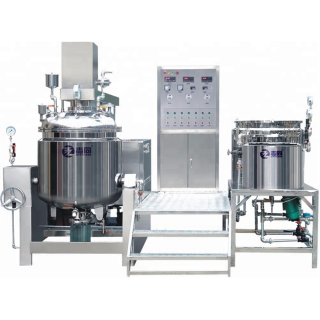The emulsifying machine is a professional equipment that completes the dispersion, emulsification and homogenization of materials through the precise cooperation of the rotor and the stator. The types of emulsifiers can be divided into kettle bottom emulsifiers, pipeline emulsifiers and vacuum emulsifiers.
1. Inspection of the emulsifier in production
During normal production, it is relatively easy for the operator to ignore the detection of the operating status of the equipment. Therefore, when the technicians of the regular emulsifier manufacturer go to the site for debugging, they will emphasize that the operator should pay attention to the operation of the equipment to avoid improper use, and detect the operation status at any time. Illegal operation results in equipment damage and material loss. The sequence of startup and feeding, the cleaning method and the selection of cleaning supplies, the feeding method, the environmental treatment during the operation, etc., all easily cause equipment damage or use safety problems due to carelessness, such as accidental foreign matter falling into the emulsification during use. The boiler is damaged (more common), the operation sequence is not in accordance with the rules to save trouble, the material is scrapped, the material that drips to the ground during manual feeding is not sorted out in time, causing personal safety problems such as slipping and bumping, etc.; all are simply ignored and afterwards It is difficult to investigate, so users are required to strengthen regulatory precautions. In addition, in the process of operation, if there are abnormal phenomena such as abnormal noise, odor, and sudden sensation, the operator should check it immediately and deal with it properly, and must put an end to the thought of reprocessing after the production is over, so as to avoid serious damage and loss caused by sick operation.
2. the reset of the emulsifier after production
The work after the production of the equipment is also very important and easily neglected. After the production, many users have completely cleaned the equipment as required, but the operator may forget the reset steps, which may easily damage the equipment or leave a safety hazard. After using the equipment, pay special attention to the following points:
1. Evacuate the liquid, gas, etc. in each process pipeline. If automatic or semi-automatic equipment is used for pipeline transportation, attention should also be paid to handling the materials in the pipeline according to the rules;
2. Clean the sundries in the buffer tank and keep the buffer tank clean;
3. Sort out the vacuum pump, check valve, etc. of the vacuum system (if it is a water ring vacuum pump, pay attention to the need to jog and check before the next operation, if the rust is dead, it must be manually removed and then energized);
4. Each mechanical part is reset to normal state, and the inner pot and jacket keep the vent valve normally open;
5. Turn off each branch power supply and then turn off the main power supply.
Post time: Jan-14-2022





